Themed collection Recent Progress on Aggregation-Induced Emission

Ligand functionalized copper nanoclusters for versatile applications in catalysis, sensing, bioimaging, and optoelectronics
Chemically synthesized copper nanoclusters show colour-tunable emission and can be applied in catalysis, sensing, bioimaging, theranostics, and optoelectronics.

Mater. Chem. Front., 2019,3, 2326-2356
https://doi.org/10.1039/C9QM00492K
Utilization and prospects of electrochemiluminescence for characterization, sensing, imaging and devices
This review summarizes the recent developments of a large number of chemiluminescent lumiphores and broad ECL applications.

Mater. Chem. Front., 2019,3, 2246-2257
https://doi.org/10.1039/C9QM00426B
Sparks fly when AIE meets with polymers
The special structure of AIEgens facilitates the understanding and application of polymers.

Mater. Chem. Front., 2019,3, 2207-2220
https://doi.org/10.1039/C9QM00404A
Fluorescent gels: a review of synthesis, properties, applications and challenges
Soft material gels are important biomaterials for tissue engineering and biomedicine. Fluorescent gels possess the additional property of being light emitting, with advanced applications in sensing, bioimaging, and electrofluorochromic devices.

Mater. Chem. Front., 2019,3, 1489-1502
https://doi.org/10.1039/C9QM00127A
Pyrene-based aggregation-induced emission luminogens and their applications
Pyrene shows very weak or quenched fluorescence in the solid state, but it is possible to turn it to a bright solid emitter by using aggregation-induced emission (AIE) strategies.

Mater. Chem. Front., 2019,3, 762-781
https://doi.org/10.1039/C9QM00090A
AIEgen bioconjugates for specific detection of disease-related protein biomarkers
Mis-regulation of certain proteins and enzymes is often identified as an indicator of many pathologies, and these disease-related proteins can be used as biomarkers to diagnose disease onset and progression.

Mater. Chem. Front., 2019,3, 12-24
https://doi.org/10.1039/C8QM00383A
Recent progress in the mechanofluorochromism of distyrylanthracene derivatives with aggregation-induced emission
A panoramic review of the recent advances in the mechanofluorochromism of distyrylanthracene derivatives with aggregation-induced emission properties.

Mater. Chem. Front., 2018,2, 1595-1608
https://doi.org/10.1039/C8QM00130H
Recent advances in mechano-responsive luminescence of tetraphenylethylene derivatives with aggregation-induced emission properties
A panoramic review of the latest progress regarding mechano-responsive luminescence of tetraphenylethylene derivatives with aggregation-induced emission properties.

Mater. Chem. Front., 2018,2, 861-890
https://doi.org/10.1039/C8QM00062J
Efficient red luminogen with aggregation-induced emission for in vivo three-photon brain vascular imaging
DCPE-TPA exhibits three morphologies with high quantum yields and nanoparticles of DCPE-TPA are utilized for in vivo 3PF imaging, achieving a penetration depth of 300 μm with a high resolution of 1.8 μm and a high signal-to-background ratio of 14.
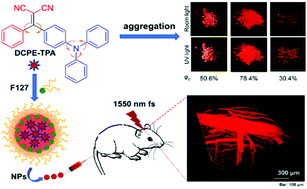
Mater. Chem. Front., 2020,4, 1634-1642
https://doi.org/10.1039/D0QM00284D
AIEgen based polymorphs with solvent regulated crystal-to-crystal switch properties
An AIEgen with tunable polymorphism-dependent emission and solvent regulated crystal-to-crystal switch properties is reported. Our study has provided insight into the relationship between molecular stacking and emission properties.

Mater. Chem. Front., 2020,4, 1773-1780
https://doi.org/10.1039/D0QM00154F
Each phenyl group performs its own functions on luminescence: phenyl substituted effect in tetraphenylpyrazine
Three phenyl groups of TPP derivatives affect the luminescence process in various modes. TPPs show AIE thanks to the ortho substituted groups, while meta and para groups can modulate their luminescence in different extents.

Mater. Chem. Front., 2020,4, 1706-1713
https://doi.org/10.1039/D0QM00098A
Multiring-induced multicolour emission: hyperbranched polysiloxane with silicon bridge for data encryption
The presented work shows an impressive multicolour luminescence hyperbranched polysiloxane attributed to the multiring through-space conjugation named “multiring induced multicolor emission” (MIE), as well as its application in data encryption.

Mater. Chem. Front., 2020,4, 1375-1382
https://doi.org/10.1039/D0QM00075B
A turn-off fluorescent probe for the detection of Cu2+ based on a tetraphenylethylene-functionalized salicylaldehyde Schiff-base
A tetraphenylethylene-functionalized salicylaldehyde Schiff-base fluorescent probe (TPE-An-Py) with aggregation-induced enhanced emission (AIEE) characteristics exhibited high sensitivity towards copper(II) ions in aqueous media with a “turn-off” fluorescence mechanism; limit of detection is 2.36 × 10−7 mol L−1.

Mater. Chem. Front., 2020,4, 1500-1506
https://doi.org/10.1039/C9QM00759H
From simple Katritzky salts to AIEgens: mechanochromic luminescence and heparin detection
A series of novel AIEgens based on Katritzky pyridinium salts were readily synthesized and exhibited interesting aggregation-induced emission behaviors, remarkable mechanochromic luminescence, and promising heparin detection.
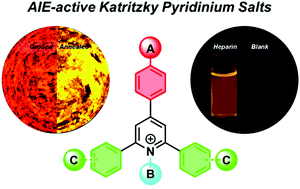
Mater. Chem. Front., 2020,4, 1492-1499
https://doi.org/10.1039/C9QM00783K
AIE-active Schiff base compounds as fluorescent probes for the highly sensitive and selective detection of Fe3+ ions
AIE-active Schiff base compounds were synthesized and photophysical properties were investigated. The compounds exhibited prominent sensing behaviour towards Fe3+ ion with enhanced selectivity, high association constants and low detection limits.

Mater. Chem. Front., 2020,4, 1471-1482
https://doi.org/10.1039/C9QM00792J
The origin of the unusual red-shifted aggregation-state emission of triphenylamine-imidazole molecules: excimers or a photochemical reaction?
Revealing the actual origin of the unusual red-shifted aggregation-state emission of triphenylamine-imidazole molecules: is the photochemical reaction rather than the excimers.

Mater. Chem. Front., 2020,4, 1411-1420
https://doi.org/10.1039/C9QM00737G
Aggregation-induced emission polymers for high performance PLEDs with low efficiency roll-off
AIE polymers pTPE-DPA-Cz and pTPE-DPA-Flu are synthesized and used as emitting layers in doped and non-doped polymeric LEDs through a solution process, and show maximum EQE of 3.26% in the doped PLEDs and CE of 3.69 cd A−1 for the non-doped PLEDs and low efficiency roll-off.

Mater. Chem. Front., 2020,4, 1206-1211
https://doi.org/10.1039/D0QM00012D
Aggregation-induced emission of a 2D protein supramolecular nanofilm with emergent functions
A 2D protein supramolecular nanofilm exhibiting aggregation-induced emission is synthesized at the air/water interface or on a solid surface in several minutes, which could be used in anti-counterfeiting for edible items or living creatures.

Mater. Chem. Front., 2020,4, 1256-1267
https://doi.org/10.1039/D0QM00031K
Pillar[5]arene-based tunable luminescent materials via supramolecular assembly-induced Förster resonance energy transfer enhancement
Supramolecular ensembles based on AIE-active pillararenes exhibit strongly enhanced emission accompanied with obvious colour changes upon assembly, where supramolecular assembly-induced enhanced emission and FRET process play key roles.
![Graphical abstract: Pillar[5]arene-based tunable luminescent materials via supramolecular assembly-induced Förster resonance energy transfer enhancement](/lv/Image/Get?imageInfo.ImageType=GA&imageInfo.ImageIdentifier.ManuscriptID=C9QM00741E&imageInfo.ImageIdentifier.Year=2020)
Mater. Chem. Front., 2020,4, 950-956
https://doi.org/10.1039/C9QM00741E
Aggregation enhances luminescence and photosensitization properties of a hexaiodo-BODIPY
The synthesis of a hexaiodinated BODIPY molecule is reported which exhibits excellent photosensitization and luminescence properties in the aggregated state.

Mater. Chem. Front., 2020,4, 965-972
https://doi.org/10.1039/D0QM00010H
Achieving remarkable and reversible mechanochromism from a bright ionic AIEgen with high specificity for mitochondrial imaging and secondary aggregation emission enhancement for long-term tracking of tumors
An ionic AIEgen with high fluorescence quantum yield shows remarkable and reversible mechanochromism as well as excellent mitochondrial imaging of cancer cells and long-term tracking of tumors.

Mater. Chem. Front., 2020,4, 941-949
https://doi.org/10.1039/C9QM00744J
One-step, rapid fluorescence sensing of fungal viability based on a bioprobe with aggregation-induced emission characteristics
A smart AIEgen has been developed to rapidly (5 minutes) and precisely differentiate fungal viability in a wash-free manner.

Mater. Chem. Front., 2020,4, 957-964
https://doi.org/10.1039/C9QM00732F
Helicene-derived aggregation-induced emission conjugates with highly tunable circularly polarized luminescence
Helicene-AIE conjugates with tailored marriage of helicenes and AIE luminophores show prominent fluorescence in the aggregated state with colour varying from blue to green, quantum yield up to 37.0%, and |glum| value up to 0.015.
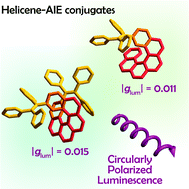
Mater. Chem. Front., 2020,4, 837-844
https://doi.org/10.1039/C9QM00652D
Tunable benzothiadiazole-based donor–acceptor materials for two-photon excited fluorescence
Spectrally tunable, two-photon active benzothiadiazole-based fluorescent materials are realized by a simple synthetic strategy. Deep red emission from two-photon absorption, and incorporation into water-soluble polymer dots are achieved.

Mater. Chem. Front., 2020,4, 555-566
https://doi.org/10.1039/C9QM00627C
Tuning aggregation-induced emission nanoparticle properties under thin film formation
The preparation of AIE nanoparticles under thin film formation controls their size and the associated fluorescent intensity, with the smaller nanoparticles significantly increasing brightness.

Mater. Chem. Front., 2020,4, 537-545
https://doi.org/10.1039/C9QM00585D
Aggregation-induced emission characteristics of o-carborane-functionalized fluorene and its heteroanalogs: the influence of heteroatoms on photoluminescence
o-Carborane was used to alter the electronic states of π-conjugated organic aryls and was demonstrated as an effective electronic control unit to tune the photophysical properties, endowing the molecules with certain luminescence properties.

Mater. Chem. Front., 2020,4, 257-267
https://doi.org/10.1039/C9QM00621D
Utilizing the aggregation-induced emission phenomenon to visualize spontaneous molecular directed motion in the solid state
A rod-like AIEgen was developed for real-time visualization of spontaneous molecular directed motion in situ, providing rich kinetic information.
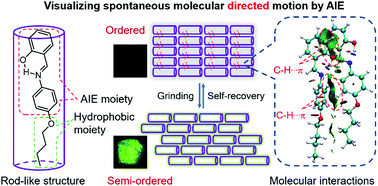
Mater. Chem. Front., 2019,3, 2746-2750
https://doi.org/10.1039/C9QM00586B
Design and performance study of high efficiency/low efficiency roll-off/high CRI hybrid WOLEDs based on aggregation-induced emission materials as fluorescent emitters
AIEgens TPB-AC and CP-BP-PXZ are used as non-doped blue and green layers, and Ir(dmppr-mp)2(divm) doped TCTA is used as red layer to construct high-performance hybrid WOLEDs.

Mater. Chem. Front., 2019,3, 2652-2658
https://doi.org/10.1039/C9QM00539K
On-site visual discrimination of transgenic food by water-soluble DNA-binding AIEgens
Development of affordable, simple and effective methods for rapid on-site identification of genetically modified organisms (GMO) is urgent due to public concern for transgenic food.

Mater. Chem. Front., 2019,3, 2647-2651
https://doi.org/10.1039/C9QM00279K
Fluorescent aggregation-induced emission (AIE)-based thermosetting electrospun nanofibers: fabrication, properties and applications
Preparation and study of the rapid formation of electrospun fluorescent thermosetting fibers via chemical knitting of a thermosetting polymer with AIEgens and their possible applications as fluorescent probes.

Mater. Chem. Front., 2019,3, 2491-2498
https://doi.org/10.1039/C9QM00342H
Ultrasensitive detection of aqueous Cu2+ ions by a coumarin-salicylidene based AIEgen
This work reports the aggregation induced emission (AIE) behaviour of a coumarin-salicylidene Schiff base probe 3 which demonstrates ultrasensitive detection of aqueous Cu2+ ions in nanomolar range via a fluorescence “on–off” strategy.

Mater. Chem. Front., 2019,3, 2437-2447
https://doi.org/10.1039/C9QM00394K
Aggregation induced emission enhancement by plasmon coupling of noble metal nanoparticles
Aggregation induced plasmon coupling enhanced fluorescence of a pre-quenched chromophore has been demonstrated by using Au and Au@Ag nanoparticles, which could be further utilized to develop highly sensitive chemical and biological sensing schemes.

Mater. Chem. Front., 2019,3, 2421-2427
https://doi.org/10.1039/C9QM00455F
Flexible control of excited state transition under pressure/temperature: distinct stimuli-responsive behaviours of two ESIPT polymorphs
The conversion between normal emission and ESIPT can be successfully achieved under pressure and temperature.

Mater. Chem. Front., 2019,3, 2128-2136
https://doi.org/10.1039/C9QM00395A
An AIE molecule featuring changeable triplet emission between phosphorescence and delayed fluorescence by an external force
A newly designed molecule ODFRPTZ with asymmetric D–A–D′ type structure is endowed with aggregation-induced emission (AIE), intriguing mechanochromism and changeable emission between delayed fluorescence and phosphorescence by external force.

Mater. Chem. Front., 2019,3, 2151-2156
https://doi.org/10.1039/C9QM00509A
Bright electrochemiluminescent films of efficient aggregation-induced emission luminogens for sensitive detection of dopamine
Bright and tunable ECL solid films are fabricated based on AIE luminogens for rapid and sensitive detection of dopamine.
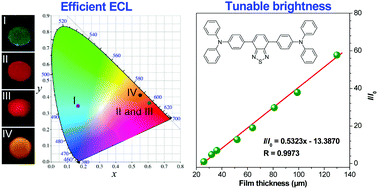
Mater. Chem. Front., 2019,3, 2051-2057
https://doi.org/10.1039/C9QM00401G
Tunable aggregation-induced circularly polarized luminescence of chiral AIEgens via the regulation of mono-/di-substituents of molecules or nanostructures of self-assemblies
Tunable aggregation-induced CPL signals with the maximal glum up to 0.02 were obtained from chiral AIEgens through the regulation of mono-/di-substituents of molecules or nanostructures of self-assemblies.

Mater. Chem. Front., 2019,3, 2066-2071
https://doi.org/10.1039/C9QM00358D
Tunable circularly polarized luminescence from molecular assemblies of chiral AIEgens
A tunable CPL response is achieved through regulating the aggregated structures of AIEgens in solution and solid states. Interestingly, DPCE-ECh exhibits a smectic C* phase with a high dissymmetry factor (gCD = −0.20 and glum = +0.38).

Mater. Chem. Front., 2019,3, 1768-1778
https://doi.org/10.1039/C9QM00332K
A novel family of AIE-active meso-2-ketopyrrolyl BODIPYs: bright solid-state red fluorescence, morphological properties and application as viscosimeters in live cells
AIE-active and bright solid-state red-emissive meso-2-ketopyrrolyl BODIPYs have been developed as viscosimeters in live cells for real-time quantification of intracellular viscosities.

Mater. Chem. Front., 2019,3, 1823-1832
https://doi.org/10.1039/C9QM00154A
Chirality-activated mechanoluminescence from aggregation-induced emission enantiomers with high contrast mechanochromism and force-induced delayed fluorescence
A pair of AIE enantiomers exhibit chirality-activated mechanoluminescence and circularly polarized luminescence, as well as force-induced multiple-variations in emission properties.

Mater. Chem. Front., 2019,3, 1800-1806
https://doi.org/10.1039/C9QM00312F
Deep insights into polymorphism initiated by exploring multicolor conversion materials
The two isomers exhibit almost identical solvatochromism and AIE activity but high-contrast polymorphism and mechanochromism.

Mater. Chem. Front., 2019,3, 1661-1670
https://doi.org/10.1039/C9QM00293F
Regulation of circular dichroism behavior and construction of tunable solid-state circularly polarized luminescence based on BINOL derivatives
Circular dichroism behavior was regulated by controlling the molecular conformation of BINOL derivatives, and tunable solid-state circularly polarized luminescence was achieved.

Mater. Chem. Front., 2019,3, 1613-1618
https://doi.org/10.1039/C9QM00292H
A diphenylamino-substituted cationic cyclometalated Ir(III) complex: its aggregation-induced phosphorescent emission and oxygen sensing properties
A new diphenylamino (DPA)-substituted cationic cyclometalated Ir(III) complex, Ir2, demonstrates aggregation-induced phosphorescent emission (AIPE) and exhibits higher sensitivity to O2 in an EC film than non-DPA-modified Ir1.

Mater. Chem. Front., 2019,3, 1593-1600
https://doi.org/10.1039/C9QM00227H
Stimuli responsive aggregation-induced emission of bis(4-((9H-fluoren-9-ylidene)methyl)phenyl)thiophene single crystals
BFMPT crystals demonstrate stimuli-responsive and conformation-dependent aggregation-induced emission.

Mater. Chem. Front., 2019,3, 1545-1554
https://doi.org/10.1039/C9QM00198K
Construction of two-dimensional supramolecular nanostructure with aggregation-induced emission effect via host–guest interactions
Formation of fluorescent two-dimensional supramolecular structure based on tetraphenylethene (TPE) derivative and CB[8].

Mater. Chem. Front., 2019,3, 1532-1537
https://doi.org/10.1039/C9QM00243J
Fluorescent thermometer based on a quinolinemalononitrile copolymer with aggregation-induced emission characteristics
An AIEgen-grafted copolymer P(NIPAM-co-EM) is successfully constructed with thermo-responsive LCST-featuring matrix PNIPAM for temperature detection.

Mater. Chem. Front., 2019,3, 1503-1509
https://doi.org/10.1039/C9QM00147F
A highly efficient and AIE-active theranostic agent from natural herbs
Berberine chloride, an AIE-active natural product, can be utilized as a highly efficient theranostic agent for cancer and bacteria.

Mater. Chem. Front., 2019,3, 1454-1461
https://doi.org/10.1039/C9QM00242A
Ionic liquid crystals with aggregation-induced emission properties based on pyrrolo[3,2-b]pyrrole salt compounds
The emission behaviors of AIE–ILC molecules (DPP-2Py-9) in different aggregation states were affected by their molecular stacking arrangements.
![Graphical abstract: Ionic liquid crystals with aggregation-induced emission properties based on pyrrolo[3,2-b]pyrrole salt compounds](/lv/Image/Get?imageInfo.ImageType=GA&imageInfo.ImageIdentifier.ManuscriptID=C9QM00208A&imageInfo.ImageIdentifier.Year=2019)
Mater. Chem. Front., 2019,3, 1385-1390
https://doi.org/10.1039/C9QM00208A
Redox-responsive fluorescent AIE bioconjugate with aggregation enhanced retention features for targeted imaging reinforcement and selective suppression of cancer cells
Redox-responsive fluorescent AIE bioconjugate with aggregation enhanced retention features for targeted imaging reinforcement and selective suppression of cancer cells.

Mater. Chem. Front., 2019,3, 1335-1340
https://doi.org/10.1039/C9QM00216B
Direct visualization of the ouzo zone through aggregation-induced dye emission for the synthesis of highly monodispersed polymeric nanoparticles
We report a new enhanced solvent displacement method for the synthesis of highly monodisperse nanoparticles with direct visualization of the ouzo zone.

Mater. Chem. Front., 2019,3, 1375-1384
https://doi.org/10.1039/C9QM00020H
A fluorescence and photoactivity dual-activatable prodrug with self-synergistic magnification of the anticancer effect
A hydroxycamptothecin prodrug is developed, which can self-report the drug distribution and achieve self-synergistic anticancer efficacy through oxidation therapy.

Mater. Chem. Front., 2019,3, 1349-1356
https://doi.org/10.1039/C9QM00081J
Syntheses, crystal structures, chirality and aggregation-induced phosphorescence of stacked binuclear platinum(II) complexes with bridging Salen ligands
Chiral Pt(II) complexes bearing bridging Salen ligands exhibit strong AIP through well-tuned intramolecular Pt–Pt interactions and multiple intermolecular interactions.

Mater. Chem. Front., 2019,3, 1199-1208
https://doi.org/10.1039/C9QM00105K
Drawing a clear mechanistic picture for the aggregation-induced emission process
Excited-state “double-bond” torsion plays an important role in the nonluminescent behaviour of a stilbene-based twisted isomer.

Mater. Chem. Front., 2019,3, 1143-1150
https://doi.org/10.1039/C9QM00156E
A multifunctional AIEgen with high cell-penetrating ability for intracellular fluorescence assays, imaging and drug delivery
A diethylamino-modified multifunctional ESIPT AIEgen with superior cell-penetrating capacity is applied for intracellular fluorescence assays, imaging and drug delivery.
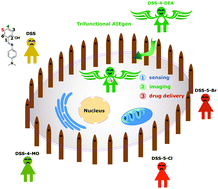
Mater. Chem. Front., 2019,3, 1151-1158
https://doi.org/10.1039/C9QM00089E
Novel fluorescent amphiphilic copolymer probes containing azo-tetraphenylethylene bridges for azoreductase-triggered release
A novel AIE fluorescent probe of amphiphilic block copolymer PCL-TPE-Azo-PEG was successfully synthesized based on azo reductase response. The polymer can be self-assembled and showed fluorescence improvement during reductant-triggered release.

Mater. Chem. Front., 2019,3, 1097-1104
https://doi.org/10.1039/C8QM00672E
A stabilized lamellar liquid crystalline phase with aggregation-induced emission features based on pyrrolopyrrole derivatives
A series of novel AIE-active liquid crystals were prepared, which exhibited stabilized and well-organized lamellar structures in the LC phase.
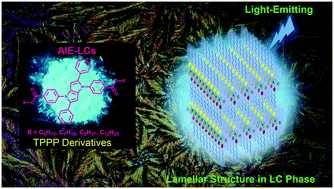
Mater. Chem. Front., 2019,3, 1105-1112
https://doi.org/10.1039/C9QM00124G
An AIE fluorescent switch with multi-stimuli responsive properties and applications for quantitatively detecting pH value, sulfite anion and hydrostatic pressure
An AIE fluorescent switch exhibited multi-parameter detection properties for pH, sulfite anion and pressure with good linear relationships.
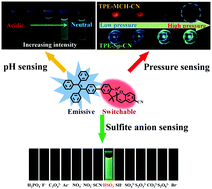
Mater. Chem. Front., 2019,3, 1052-1061
https://doi.org/10.1039/C8QM00544C
Aggregation-induced emission lights up the swelling process: a new technique for swelling characterisation of hydrogels
The characterization of the swelling properties in hydrogels suffers uncertainty due to the limitations that occur during weight change measurement.

Mater. Chem. Front., 2019,3, 664-667
https://doi.org/10.1039/C9QM00054B
An ESIPT-based fluorescent switch with AIEE, solvatochromism, mechanochromism and photochromism
In this study, we report a newly synthesized molecule 1via linking a benzothiazole to rhodamine, which could exhibit AIEE, unique acidichromism and solvatochromism in solution, fascinating photochromism in a polymer matrix, intriguing mechanochromism in solid state and remarkable piezochromism in the crystal.

Mater. Chem. Front., 2019,3, 620-625
https://doi.org/10.1039/C8QM00633D
Systematic oligoaniline-based derivatives: ACQ–AIE conversion with a tunable insertion effect and quantitative fluorescence “turn-on” detection of BSA
Conversion from ACQ to AIE was achieved in aniline oligomer derivatives based on a novel “chain-insertion” pattern. The fully substituted anilines also showed a quantitative turn-on fluorescence response towards BSA.

Mater. Chem. Front., 2019,3, 331-338
https://doi.org/10.1039/C8QM00543E
A novel strategy for realizing dual state fluorescence and low-temperature phosphorescence
We demonstrate a new strategy for the development of dual-state emissive materials with a positive response to temperature and long lifetime phosphorescence at low temperature.

Mater. Chem. Front., 2019,3, 284-291
https://doi.org/10.1039/C8QM00613J
Rational design of ratiometric and lysosome-targetable AIE dots for imaging endogenous HClO in live cells
A novel lysosome-targetable ratiometric AIE nanoprobe was rationally designed and synthesized for sensing of endogenous HClO levels in live cells.

Mater. Chem. Front., 2019,3, 203-208
https://doi.org/10.1039/C8QM00511G
Emission mechanism understanding and tunable persistent room temperature phosphorescence of amorphous nonaromatic polymers
Intrinsic emission and persistent room temperature phosphorescence from amorphous nonaromatic polymers are observed, which can be well rationalized by the CTE mechanism.

Mater. Chem. Front., 2019,3, 257-264
https://doi.org/10.1039/C8QM00528A
Rational design of aggregation-induced emission sensor based on Rhodamine B for turn-on sensing of trivalent metal cations, reversible data protection, and bioimaging
A novel AIE-active molecule (TPEThRB) composed of a tetraphenylethene unit as a AIE factor, Rhodamine spirolactam as a receptor, and thiophene ring as a conjugated electron-rich linker was obtained.
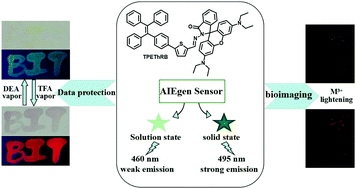
Mater. Chem. Front., 2019,3, 151-160
https://doi.org/10.1039/C8QM00424B
Influence of halogen substitution on aggregation-induced near infrared emission of borondifluoride complexes of 2′-hydroxychalcones
In this study, we investigate the role of halogen atoms on the fluorescence emission properties of borondifluoride complexes of 2′-hydroxychalcones in the solid-state.
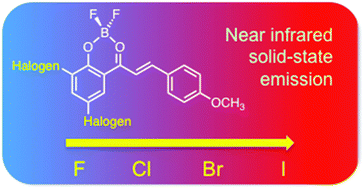
Mater. Chem. Front., 2019,3, 86-92
https://doi.org/10.1039/C8QM00478A
An o-phthalimide-based multistimuli-responsive aggregation-induced emission (AIE) system
An o-phthalimide-based AIE system was developed and used for detecting UV light, Hg(II) and pH, and as a photo-printing material.

Mater. Chem. Front., 2019,3, 50-56
https://doi.org/10.1039/C8QM00454D
Real time bioimaging for mitochondria by taking the aggregation process of aggregation-induced emission near-infrared dyes with wash-free staining
Triphenylpyrrole derivatives are designed for application in wash-free real-time mitochondrial imaging, which emit NIR signals and feature AIE characteristics.

Mater. Chem. Front., 2019,3, 57-63
https://doi.org/10.1039/C8QM00425K
Recyclable mechanoluminescent luminogen: different polymorphs, different self-assembly effects of the thiophene moiety and recovered molecular packing via simple thermal-treatment
We report a purely organic recyclable mechanoluminescent luminogen (tPE-5-MeTh) with a thiophene group as the self-assembly unit. The recoverability could be achieved through simple thermal-treatment.

Mater. Chem. Front., 2019,3, 32-38
https://doi.org/10.1039/C8QM00411K
Wavelength dependent nonlinear optical response of tetraphenylethene aggregation-induced emission luminogens
Studies of the non-linear optical properties of classical AIEgens are rare, despite their important potential applications in organic composite photonic circuits. Here, we present experimental results, supported by theoretical calculations, of the non-linear optical (NLO) properties of TPE and its halogenated derivates.

Mater. Chem. Front., 2018,2, 2263-2271
https://doi.org/10.1039/C8QM00375K
Liquid crystal gelators with photo-responsive and AIE properties
trans-Cn-Chol present smectic A phase and photo-responsive SmA–isotropic phase transition, and their organogels exhibit aggregation-induced emission and photo-responsive gel–sol transition.

Mater. Chem. Front., 2018,2, 2245-2253
https://doi.org/10.1039/C8QM00340H
Novel chiral aggregation induced emission molecules: self-assembly, circularly polarized luminescence and copper(II) ion detection
Two novel chiral molecules 1 and 2 were designed and synthesized. 1 displayed evident CPL activity, whereas 2 served as a highly selective and sensitive “turn-off” fluorescent chemosensor for Cu2+.

Mater. Chem. Front., 2018,2, 1884-1892
https://doi.org/10.1039/C8QM00294K
About this collection
Materials Chemistry Frontiers is delighted to introduce you the following collection of articles on “aggregation-induced emission”. Access is free till 20 Aug 2020.